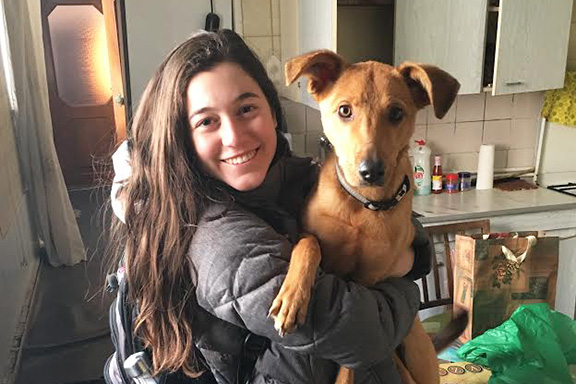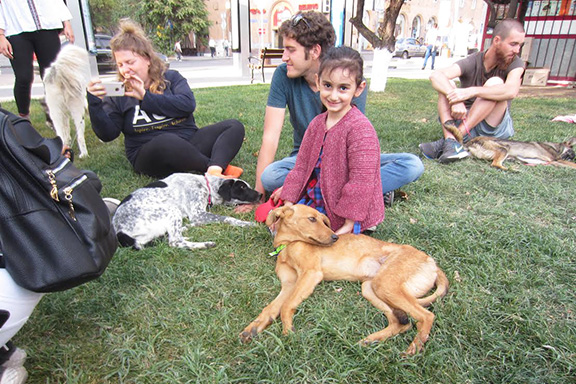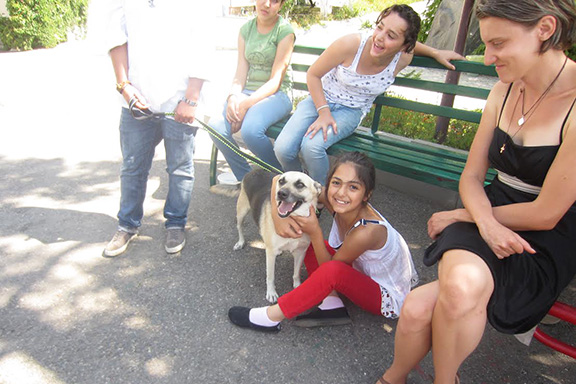
BY ALEEN ARSLANIAN
In 2016, Nairi Krafian spent 3 months in Armenia with Birthright Armenia. As a pre-veterinary student, what impacted her most during her stay was the number of stray dogs, and the relationship Armenians had with them. A lover of animals, Nairi knew the dogs had more potential than the community could recognize. She recognized the fact that the stray dogs of Armenia could bring transformative changes to the community.
Upon her return from Armenia, Nairi created Oknooshoon, a non-profit organization dedicated to connecting stray dogs with Armenian youth through canine-assisted interventions. Her goal is to simultaneously improve the lives of children and stray dogs in Armenia. Oknooshoon works to improve the community’s perception of dogs by rescuing, and training, stray dogs for therapeutic purposes.

Recently, Asbarez had the opportunity to interview Krafian about her project.
Aleen Arslanian: You first thought of this project during a visit to Armenia—when was that, and what inspired you?
Nairi Krafian: I went to Armenia for the first time when I was in the 5th grade, with my Armenian school’s class. I didn’t go back until 2016, with Sayat Nova Dance Company. We had a busy schedule, but I was able to fit in some meetings with dog shelters. Going back as an adult was really eye-opening. I saw that there are a lot of challenges that need to be addressed, and as an animal lover, something I noticed were the dogs on the streets.
Another issue I learned about was how many children live, or spend a significant amount of time in institutions. Armenia doesn’t have a foster system, so, I started to wonder: what types of services are these places providing? This is how I brought the two together. I had difficulty with my mother being sick when I was younger, as well as mental health challenges.
Knowing my dog, Choreg, was the comfort that got me through everything—I wanted that for the kids in Armenia. I saw that this type of relationship between dogs and people didn’t really exist in Armenia, I wanted to try to foster it. Not just foster it with the general public but actually use these dogs to help kids in need. I wanted to specifically use dogs that had come from the streets. There is a growing pet industry in Armenia, people love Huskies. But, a lot of them don’t equate the dogs they see on the streets with their own pets. They see the ones on the streets as a pest. I want to show them that stray dogs can do amazing things and are worth being kind to and adopting.
A.A.: How much research went into creating Oknooshoon?
N.K.: I started doing my research in 2016, and planned it out through 2017, when I went back to Armenia. I call that Phase I. I thought that I’d be able to train dogs at shelters, then have their employees take the dogs and do the work. There were 4 main issues with that method. First was that the shelter staff are very busy. The staff consists of mostly volunteers. They have so many dogs to take care of and just a handful of volunteers. I wanted this to be full time venture, having a dog work with kids every single day, and that was just not feasible. Second was that the shelters and dogs were not clean. We couldn’t ensure that they were getting their medication, and the shelter we worked with didn’t want to vaccinate. Then there was the issue of the handler. The team—I call it the canine-assisted interventions team— are the dog and their handler. And that’s one specific handler, the dog can’t just go with anyone, they have to pass the exam with their handler. Their relationship is very critical. If the dog doesn’t trust their handler, they’re more likely to act out. If the person is unable to read their dog to know when they’re stressed or nervous, it can also be very dangerous. A therapy dog really needs to have a daily connection interacting with that person, and really growing a trust for that person, the way that you develop with your pet that lives in your house. We model our curriculum after Pet Partners, which is one of the therapy animal organizations in the U.S. We adjust it to match Armenia, because we have to understand the cultural differences.

The New Phase, the phase we’re doing now—after we realized the shelter wouldn’t work—is we have a handler that we hire, and they work for us full-time. Dobby, our dog, lives with her handler. So, we just have 1 dog and 1 handler for now, and they’re training. She knows most of the commands, she’s a year old so she’s about at the point that it’s just letting her mature and get some of her energy out and making that bond. She was with a volunteer until last week, we just hired Hratch. We’re giving them that time to form a bond so she trusts him and he knows her well and can read her body language. I’m really looking forward to seeing how this pans out, and using that first team as our guinea pig to move forward and keep making this successful.”
A.A.: Where do you find, and how do you connect, the children and the dogs?
N.K.: We go to institutions that the children are involved with. The 3 we’re planning on starting with this summer are: the Women’s Support Center, Orran, and the Fund for Armenian Relief Children’s Support Center. We’re not working with individual families because that’s too difficult and would require a lot of convincing of parents. Whereas, at these 3 places, we convince the administration and they disseminate the information to the parents. I noticed that everyone that had this type of interaction going on, the kids had to go to them. A lot of families in Armenia don’t have cars. This becomes an extra hurdle that may make people not want to do it. We wanted to make this really accessible by A) having it be free for these institutions and B) going to them. So that’s another reason our dogs need to be clean. They don’t have the burden of having to come to us, and they don’t have the burden of owning a dog and having to take care of it. They get that satisfaction of that interaction with us just coming, doing our thing, and leaving. I wanted to have us go there, because I saw how unfeasible it was for most kids to get to those places. Especially the kids at these institutions, they don’t have much opportunity for the kids to get out of where they are.
A.A.: What means of transpiration do you use to transport Dobby to the institutions and back?
N.K.: I lived in Armenia for a few months in 2017 and 2018. I was able to see how see things work there. We realized a car was not a good investment in terms of cost, gas, and having to do repairs. We have drivers who we’ve formed good relationships with who allow Dobby in the car. That’s in our budget. The money that we’re raising covers the cost of the drivers. I don’t know that we’ll ever have a car, because I like being able to interact with the community and give more employment opportunities to people in Armenia. Having local drivers involved, feeling like they’re impacting something, is really nice. It’ll help us have a consistent relationship with that person once we start. The goal is to go to visit each center once a week. Dobby will do a session in the morning, take a break, and then do another session a few hours later.
A.A.: Does Oknooshoon have an office Armenia?
N.K.: No, we don’t have an office. When I was there, I was gonna get a desk at Impact Hub, but you can’t bring a dog in there. We worked out of an apartment, where my volunteers would meet me. Now my Assistant Director works from home. She’ll run errands like going to pick up food for Dobby. Dobby lives with the handler and they work from home. Yerevan is their office. His goal is to get Dobby out and experience as much as she can. I think at some point we may look back into finding a funder to get a desk at Impact Hub, just to have a point where we can meet. In the long term, we’d like to potentially have a building for the dogs to come. We’re looking into exploring other options to be more sustainable of revenue, of having a place that people can come and pay to have their pets to be trained. Or people that just want their kids to do dog therapy, to pay to come to do that. Our program, right now, is all donation based.

A.A.: With so many stigmas surrounding dogs in Armenia, what’s been the hardest one to break?
N.K.: There are a few. In 2017, when I was choosing a dog, I would bring them to Yerevan and walk around with them. It’s amazing that people there have purebred dogs, but look at you, with a dog that’s clearly not recognizable as a breed, and they’re judgmental about it. I’m starting veterinary school in the fall, and I know a lot about animals. Mixed breed dogs are healthier. Purebred dogs are essentially inbred, they form diseases. When taken care of properly, there’s not difference between a purebred and a mixed breed dog. I try to be clear that I’m not promoting that people just snatch dogs up off the street, because there’s a few terms. People say wild dogs, there’s no such thing as wild dogs. Wild dogs are actually not domesticated, and they’re in Australia. These are feral dogs. A feral dog has grown up without humans. Versus a stray dog, they’ve strayed away from their homes. Street dogs are made up of stray and feral dogs. In Armenia its mostly feral. In Massachusetts there’s no feral dog, if you see a dog on the street you know its a stray. A lot of those older dogs are not interested in being rescued. This is why rescues don’t generally rescue them, unless they’re sick or injured. The puppies you can take and train easily. Finding that balance of rescuing dogs, and explaining to people that some of them are not pets. You look at them and see your pet, but they’re not pets. I think it’s worse when we do interact with them and feed them, because they can become reliant when we leave Armenia in September. They’ll start walking up to locals and getting kicked and hit and people become afraid of them. So, it’s a much deeper issue. My goal is for them to see these creatures as loving caring beings, worthy of not being shot or poisoned. Telling their kids to keep a safe distance, but not to hurt them.
A.A.: How will the services provided by Oknooshoon impact the youth in Armenia?
N.K.: Women’s Support Center have kids that are at the shelter with their mom, they have either witnessed abuse or have been abused. The Fund for Armenian Relief Children’s Support Center is a whole slew of kid’s from different backgrounds, but it’s what would be considered foster care in the U.S. Orran is none residential, it’s an after-school program for kids that are from impoverished families. These are all kids that are getting their basic care, or even beyond that, but they don’t all necessarily have psychological care. Orran and Women’s Support Center do have psychologists on board, but even with that, children know where they stand. They feel that they’re at the bottom of the totem pole.
Our main goal is to bring the dogs in so they’re not sitting in front of a therapist that’s writing notes about them. Instead, they’re actively participating and feeling like they have a leadership role, giving them autonomy. It helps develop their social skills, because animals help with attachment issues. Kids that are at these 3 centers have some level of mistrust in their parents or their authority figures. They have trouble forming bonds even with their peers. Dogs can really help facilitate that and then those skills move on to human interactions. Even at the Fund for Armenian Relief Children’s Support Center where we did our pilot, the director said that even after we left, he noticed that the kids were nicer to each other. That’s really what we want to do. We want to help the kids and show the community—look what the dogs can do for these kids. We want to show that we’re actually helping the kids and hopefully promoting adoption and humane practices that will help solve the issue with stray dogs and the major public health problem in Yerevan, and throughout Armenia.

A.A.: What are your long-term goals for Oknooshoon?
N.K.: I’m not too focused on scaling, I’m definitely prioritizing quality over quantity. This is a non-profit, so it’s not a money making venture. I want it to be the best it can be for as many kids that it can be best for. It’s hard to find the employees and the people to build a strong team that’s going to care. I’m looking for people that are not going to just do the busy work, but really do the work to make a difference. We want to reach as far as we can while maintaining our integrity as an organization. But, I would really love to get out of Yerevan and do other cities. If we had the funding and grew to a point where we could have an office space, or even a building where the dogs lived instead of us having to find people who can house the dog, which is how we’re working now.
I did notice something over time, I call it the “Never Say it’s Good Enough for Armenia.” The shelters were saying, “Let’s do it like this, this is good enough for Armenia.” I hate when people say that, because it takes away the potential that Armenia has. We have to respect their cultural differences and how we’re going to adjust the program to fit Armenia. That doesn’t mean it should be worse, or that it doesn’t have to be as good. That doesn’t mean we sacrifice the kids safety, or the dogs safety, or anyone’s enjoyment because we just want to preview that we can do it. Yes, you can force dogs and kids to be together. You can even take pictures to prove it. But, we want to actually measure the impact on the kids and we want to see that it’s having a positive impact. We want to be the gold standard. We want other countries that haven’t used support animals thus far, to look at Armenian and say, “We want our program to be like Armenia’s.” That’s my goal. I want it to be the best it could be, because that’s what the people in Armenia deserve.
A.A.: If individuals from the U.S. or Armenia want to get involved, how would they be able to do so?
N.K.: If you’re a young adult from the U.S. thinking of interning, we have a good relationship with internship organizations. We’ve had Armenian Assembly interns and Birthright interns. This summer, we don’t have an AYF intern, but they’re doing a community service project with us. Every week we’re going to go help shelter dogs. We’re a relatively young organization, so we can use all kinds of help. If you’re an accountant, or if you want to work directly with the dogs and kids, or if you’re studying psychology and you want to focus on the research. We’re going to work with the researchers at the University of Denver Institute for Human Animal Connection. We need interns who are willing to work with our research assistants there on creating the methods, and figuring out how we’re going to measure it. We can really use everything and anything. You don’t have to necessarily be a dog person, or someone that wants to interact with the dogs to be involved. Being pre-veterinary, I like to go to the shelters and clean their ears and butts, and trim their nails, and all that basic care that they never get.
In July, I plan an event and they help me: hold the dogs, check off the names of those we cleaned, take pictures and videos of what we’re doing, take pictures of a wound if there’s something we need to show the shelter, or if there’s a dog that has an ear infection, to write that down. It’s dirty, but it’s fun. Having the extra hands there is helpful. We go for 2 – 3 hours and you really feel the impact you had directly on those animals. In Armenia, we also take volunteers. We had two high school students volunteer with us last summer who helped us take care of Dobby. We’re always open to more volunteers. We’re also looking to build our advisory board for adults with professional experience. Having that net of support for when we have questions of how things are done. We want to make sure we’re complying with everything in both U.S. and Armenia.
Donations to Oknooshoon can be made through the Paros Foundation. For more information, visit their Facebook and Instagram pages, send an email , or call +1 617 930 3060.











